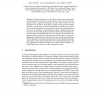Free Online Productivity Tools
i2Speak
i2Symbol
i2OCR
iTex2Img
iWeb2Print
iWeb2Shot
i2Type
iPdf2Split
iPdf2Merge
i2Bopomofo
i2Arabic
i2Style
i2Image
i2PDF
iLatex2Rtf
Sci2ools
TACAS
2001
Springer
2001
Springer
Coverage Metrics for Temporal Logic Model Checking
In formal verification, we verify that a system is correct with respect to a specification. Even when the system is proven to be correct, there is still a question of how complete the specification is, and whether it really covers all the behaviors of the system. In this paper we study coverage metrics for model checking. Coverage metrics are based on modifications we apply to the system in order to check which parts of it were actually relevant for the verification process to succeed. We introduce two principles that we believe should be part of any coverage metric for model checking: a distinction between state-based and logicbased coverage, and a distinction between the system and its environment. We suggest several coverage metrics that apply these principles, and we describe two algorithms for finding the uncovered parts of the system under these definitions. The first algorithm is a symbolic implementation of a naive algorithm that model checks many variants of the origin...
Related Content
| Added | 30 Jul 2010 |
| Updated | 30 Jul 2010 |
| Type | Conference |
| Year | 2001 |
| Where | TACAS |
| Authors | Hana Chockler, Orna Kupferman, Moshe Y. Vardi |
Comments (0)

